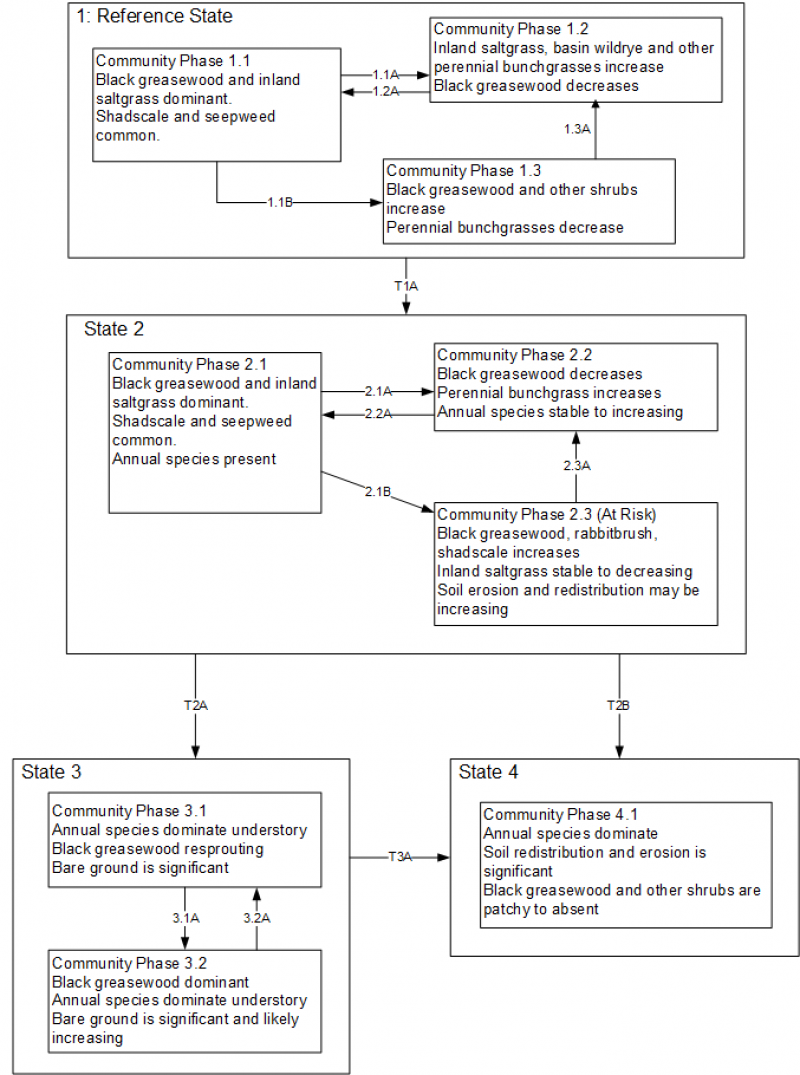
Natural Resources
Conservation Service
Ecological site R027XY025NV
SODIC FLAT
Last updated: 6/03/2024
Accessed: 04/27/2025
General information
Provisional. A provisional ecological site description has undergone quality control and quality assurance review. It contains a working state and transition model and enough information to identify the ecological site.
MLRA notes
Major Land Resource Area (MLRA): 027X–Fallon-Lovelock Area
Physiography
Found in the Great Basin Section of the Basin and Range Province of the Intermontane Plateaus this area is characterized by isolated uplifted fault block mountain ranges trending north to south that are separated by broad, hydrologically closed basins. The entire area occurs in the rain-shadow of the Sierra Nevada mountains and is influenced by Pleistocene Lake Lahontan which reached its most recent high stand about 12,000 years ago. There is substantial evidence suggesting the western Great Basin has been the site of pluvial-interpluvial cycles for at least the past two million years.
The mountains and valleys are dissected by the Humboldt, Truckee, Carson, and Walker Rivers and their tributaries, all of which terminate within MLRA 27. Extensive playas can be found throughout this area and are the result of drying of ancient Lake Lahontan. Elevation generally ranges from 3,300 to 5,900 feet (1,005 to 1,800 meters) in valleys, but on some mountain peaks it is more than 7,870 feet (2,400 meters).
Geology
Landforms and soils of this MLRA have been heavily influenced by fluctuating lake level over the last 40,000 years. There is a level line evident on the higher slopes marking the former extent of glacial Lake Lahontan. Almost half of this area has surface deposits of alluvial valley fill influenced by lacustrine sediment. The rest has andesite and basalt rocks of different ages. Mesozoic and Tertiary intrusives are concentrated along the western border of the area, and Lower Volcanic Rocks (17 to 43 million years old) are common on the eastern side of the area. Also, some scattered outcrops of Mesozoic sedimentary and volcanic rocks and tuffaceous sedimentary rocks are in the mountains within the interior of this MLRA.
Climate
The average annual precipitation is 5 to 10 inches (125 to 255 millimeters) in most of the area but is as much as 19 inches (485 millimeters) on high mountain slopes. Most of the rainfall occurs as high-intensity, convective thunderstorms during the growing season. The amount of precipitation is very low from summer to midautumn. The precipitation in winter occurs mainly as snow. The average annual temperature is 43 to 54 degrees F (6 to 12 degrees C). The freeze-free period averages 155 days and ranges from 110 to 195 days, decreasing in length with elevation.
Water
The amount of precipitation is very low, and water for irrigation is obtained principally from diversions on the four large rivers in the area and from water stored in the Lahontan, Rye Patch, and Weber Reservoirs. Pyramid Lake and Walker Lakes are terminal lakes for the Truckee and Walker Rivers, respectively. Much of the annual flow of both rivers is diverted for irrigation, causing lake levels to fall and levels of dissolved salts to increase causing problems for the native Lahontan cutthroat trout.
Soils
The dominant soil orders are Aridisols and Entisols. The soils in the area are predominantly a mesic temperature regime, aridic moisture regime, and have a mixed mineralogy. They are generally well drained, loamy or sandy, commonly skeletal, and shallow to very deep. Accumulation of salts, tufa deposits, and eolian sediments with soluble salts over lacustrine deposits influence most of the soils in the basin landforms of this MLRA. Soils on bedrock-controlled landforms are typically comprised of volcanic or tuffaceous sedimentary colluvium over residuum.
Biological Resources
This area supports extensive areas of salt-desert shrub vegetation. Shadscale and Bailey’s greasewood are widespread, occurring both individually and together. Grasses are generally sparse, although Indian ricegrass is prominent, especially on the sandy soils. Fourwing saltbush, winterfat, spiny hopsage, wolfberry, ephedra, dalea, and bud sagebrush are common shrubs. Basin wildrye, creeping wildrye, alkali sacaton, saltgrass, black greasewood, rubber rabbitbrush, and big saltbush are important plants on saline bottom lands and terraces. A few marsh areas support cattail, bulrushes, sedges, and rushes. Big sagebrush, along with scattered Utah juniper and singleleaf pinyon, is associated with Thurber needlegrass, desert needlegrass, Sandberg bluegrass, and squirreltail on the higher elevation piedmont slopes and mountains.
Ecological site concept
The Sodic Flat site occurs on alluvial flats, stream terraces and lake plains. Slope gradients range from 0 to 2 percent. Elevations are 3800 to 5600 feet. The soils associated with this site are very deep, moderately well drained to well drained and have formed in mixed alluvium. The soils are strongly to very strongly alkaline.
Associated sites
| R027XY016NV |
SODIC DUNES ACHY dominant grass; occurs on sand hill (dune) landform |
|---|
Similar sites
| R027XY006NV |
SALINE BOTTOM LECI4 dominant plant; more productive site |
|---|---|
| R027XY036NV |
DRY SODIC TERRACE SAVE4-ATCO codominant shrubs; LYSH important shrub |
| R027XY024NV |
SODIC TERRACE SAVE4-ATCO codominant shrubs |
| R027XY012NV |
SODIC SANDS ACHY dominant grass |
Table 1. Dominant plant species
| Tree |
Not specified |
|---|---|
| Shrub |
(1) Sarcobatus vermiculatus |
| Herbaceous |
(1) Distichlis spicata |
Click on box and path labels to scroll to the respective text.

